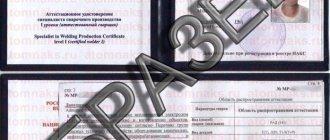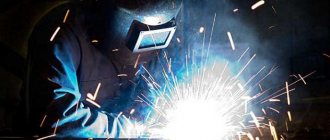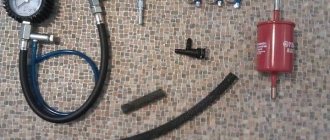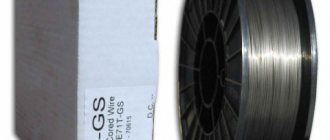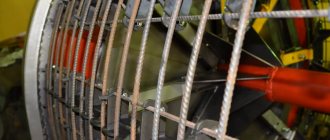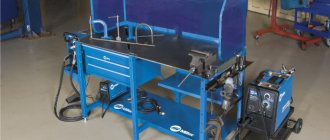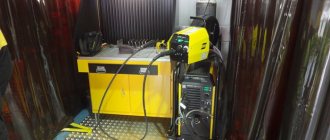Welding is always associated with various kinds of dangers: from the possibility of fire to physical injuries at the machine. In addition, the welding process is rarely performed by one single worker. Most often this is a whole team of welders, controllers, engineers, and so on.
Therefore, it is important to properly implement all fire safety measures and designate those responsible who will be responsible for the result. All this information is recorded in the permit. In this article we will tell you in detail whether a welding permit is needed and how to properly issue it.
general information
A work permit is a task for performing welding work. It is drawn up on a special form, and in no case in free form. The work permit specifies the location of the welding, the start and end times of welding, and whether safety measures have been observed. The entire staff of employees participating in the work is also indicated. Once employees have been included in the work permit, they automatically become responsible persons and are responsible for the final result.
Newcomers who don’t want to waste time filling out unnecessary paperwork often wonder whether the permit is so important? Is it possible to fill it out in any form or not fill it out at all? Short answer: no. The fact is that welding is a hot work. And they are legally considered dangerous to health and/or life. Therefore, to perform such work, in any case, you need an outfit, otherwise you simply will not be allowed to do it.
But not all types of welding are hot work. In principle, you yourself can determine which welding technologies fit this law. We'll tell you. This includes gas welding, electric welding, soldering, metal cutting using electricity and gas. In general, any welding during which there is an open flame, sparks or heating of parts is considered fire welding. In a word, all types of welding, which are called thermal.
What is a work permit for hot work?
A document authorizing workers to begin hazardous work, including hot work, must be drawn up before starting it. It is necessary for temporary work (with the exception of construction sites and private households), as well as in other cases determined by the company’s regulatory documents.
Fire work includes types of work associated with the use of the following tools:
- gas-, electric-, gasoline- and keratin-cutting soldering;
- metal cutting;
- welding based on gas or electricity.
This also includes fire heating of bitumen and other types of work that may be listed in the organization’s regulations.
When obtaining access to such types of work, you must be guided by the Fire Safety Rules, approved by Government Decree No. 390 dated April 25, 2012. The form of the document is Appendix No. 4 to the Rules.
A work permit is a task for the safe performance of work with fire, which specifies not only the content of the required work, but also:
- the period of its implementation;
- composition of responsible employees;
- safety measures used during the execution of the task;
- briefing notes.
After receiving a permit, the team is obliged to act only within its framework. It is drawn up in two copies (one for the work manager and one for the person responsible for fire safety in the organization) for a period not exceeding 15 days. In some cases, the period may be extended, but not by more than 15 days. Closed orders must be stored in the organization for a month after their completion.
Before filling out the paperwork
Before you start filling out the work permit, you need to ensure your working conditions and comply with fire safety standards. It is advisable to carry out work during daylight hours; only employees with the necessary qualifications who are able to confirm it documented and in practice are allowed to work. Also, the head of a team or workshop is obliged to write out a clear and understandable work plan, as well as notify other workers about it.
At the same time, the manager must conduct safety training and distribute fire protection equipment. Welding workstations must be properly staffed and prepared. All equipment must work properly.
If there are departments in the workshop where there is a high probability of an explosion, then safe equipment should be installed in such places. It should not threaten the life and health of workers. Particularly dangerous areas should be identified with identification signs.
If the measures described above are completed, then a permit for welding work can be issued.
Necessary requirements for registration
A work permit for welding tasks is never issued freely, a strict form will be required, and any authorizations made without this form are considered invalid. Sometimes production makes their own forms. This is acceptable, but only if all parts of the base version are preserved.
Before registration begins, the workplace is prepared and inspected. First, the work area itself is checked, then the equipment located in it, and then personal protective equipment. If something is faulty or damaged, a permit can be issued only after all defects have been eliminated.
Filling rules
The rules for filling out are simple and there are few of them. The main ones are stated in paragraph No. 437 of the “Fire Regulations in the Russian Federation”. According to this set of rules, a standard permit is issued for welding work. The permit can be printed on a regular A4 sheet, or it can be issued in the form of the company’s letterhead.
The work order for welding work is issued either by the manager or by the welder, if he has these powers. The order is filled out in two copies. One is given to the welder, and the second to the workshop manager.
To be allowed to perform hot work, you must have sufficient qualifications. It is also indicated in the permit. Qualifications must correspond to the type of work performed. These are the basic rules.
Among the minor rules, we highlight the absence of grammatical errors in admission, legible handwriting (if the work order is filled out manually and not on a computer), and the ink of the pen must be of a contrasting color (black, red, blue). The use of pencils, markers, etc. is not allowed. The permit must be filled out on a clean surface and with clean hands so that there are no traces of oil or dirt on the sheets.
Actions of workers in case of fire
Every employee who is allowed to perform hazardous production tasks must know how to behave correctly in the event of a fire:
- The employee must stop performing his professional duties and urgently leave the production site.
- Officials are notified of the emergency that has occurred.
- Measures are being taken to eliminate fires.
- Electricity and gas supplies are turned off.
- If necessary, firefighters, doctors, gas rescue services, etc. are called.
- All employees are removed from the danger zone.
The permit must be issued for one employee
, which is assigned specific tasks. The validity period of the document does not exceed one work shift, after which it is handed over to the workers to the site manager.
In the event that a specialist did not have time to complete his scope of work, his work permit can be extended by no more than one shift
an official who has previously agreed on this fact with the fire department inspector.
When issuing a work permit, all requirements of Federal legislation must be met:
- The exact plan and list of activities are indicated.
- A person is appointed who is entrusted with the execution of the production process.
- Information about the fire safety measures taken is provided.
- The production area where fire manipulations will be carried out is determined.
- Responsible persons are indicated.
The work permit is not a unified form
, therefore, each business entity can independently develop a document and consolidate it in the accounting policy.
To design an outfit, you can use a regular sheet of A4 paper, on which you should indicate the details of the organization. After issuance, the document is certified by the company’s seal and the signature of the official.
Sample filling
Let's start filling it out. We have prepared a detailed sample for you to fill out; we will tell you what to write and in which column. Even those who have never seen a work permit will be able to fill it out correctly after reading our article.
In the upper left corner you must indicate the full name of the enterprise where welding work is carried out and the welding area (or division). In the upper right corner you need to indicate the director of the enterprise, his full name, leave space for a signature and indicate the date of the work.
Next you need to write down 8 main points. In paragraph 1, indicate who exactly is entrusted with issuing a work permit for welding work. Subsequently, this person will be the person responsible for carrying out all welding work. In paragraph 2, indicate the type of welding work, and in paragraph 3, the location of the work (full address and name of the organization, if the work is not carried out in the workshop).
A separate table is provided under point 4, in which you need to indicate all employees involved in the work. The name of the welder, his rank, personal signature and date of work are indicated. A signature is required, so the welder confirms that he is familiar with the instructions, work plan and this work permit.
In paragraph 5, indicate the start and end time of the work. Specific hours and dates are indicated. Point 6 is one of the most important; it specifies all fire safety measures that will be observed during welding work. Measures may vary depending on the type of work and its volume, so they are usually not prescribed in advance.
Paragraph 7 indicates whether this document has been agreed upon with a representative of the organization with which you are conducting your work. Usually the work is coordinated with the labor protection manager. His full name is indicated and space is allocated for his signature.
Last paragraph 8. It indicates the responsible person responsible for preparing the work site. Usually this is the chief engineer. His full name is also indicated and space is allocated for his signature.
These are the main points. There may also be additional ones. For example, the welders, for objective reasons, did not have time to complete the work within the period specified in paragraph 5. In this case, paragraph 9 is filled out, which indicates until what period the work can be extended. Please note that the extension period should not exceed one welder shift. That is, it is impossible to extend the completion of work by three days, for example.
Next, fill out paragraph 10. It indicates information that the work has been extended and agreed with the labor protection supervisors (from paragraph 7). Sometimes there are situations when one welder replaces another (for objective or subjective reasons). In this case, paragraph 11 is prescribed, in which a table is again drawn up, where all new employees are indicated.
If all the main and/or additional items are completed, you need to fill out the last item. He will be either ninth or twelfth respectively. The last paragraph contains information that the work was completed in full on time, all workplaces were cleaned, and the work permit was completed. All that remains is to register the head of the site or enterprise, his full name and get his signature.
That's all, the permit is completed. The main thing is that all signatures are obtained, otherwise such a document is invalid. Of course, at first you may be confused in some graphs. Especially if you are a welder who has been tasked with filling out the permit, and this is not your direct responsibility. But check, after a couple of these papers you will be able to fill them out in a matter of minutes.
Purpose, terms and definitions
The following terminology is fixed in the relevant regulatory legal acts:
- Hot work
. All operations carried out in production in which an open flame is used, sparks are formed, and the structures being processed are heated to high temperatures. - Emergency work
. Carrying out activities aimed at eliminating any types of malfunctions that could lead to a fire or explosion, as well as cause death or injury to people. - A designated production area for conducting fire activities
. A specially equipped area where work can be carried out without a previously issued permit. - An undesignated production area for conducting fire activities
. An area where flammable work can be carried out only if there is a permit and compliance with fire safety standards. - Dangerous territory
. A production area where hot work can be carried out only during the daytime, except for emergency measures. - Work permit
. A special document that is drawn up by an official and certified by his signature. - Performer of fire activities
. An employee of the organization who has the appropriate qualifications and education, has passed safety certification, and is over 18 years of age. - Observer
. An employee of an organization who takes part in fire activities, knows how to handle fire extinguishing equipment and is able to provide first aid to victims.
Instructions for filling out the form
- At the top of the document, on the right side, all details are indicated.
- At the top of the order, on the left side, information about the head of the organization is indicated, and the date of execution of the document is also indicated. After discharge, the boss puts his signature here.
- Below you should write the name “permit order”.
- The full name, profession and qualifications of the person to whom the document was issued are indicated, the tasks assigned to the employee are described, and information about the object (address and name) is indicated.
- The date of the last briefing is entered. The employee will have to sign next to his full name.
- Start and end times of fire activities.
- Fire safety measures taken, which are agreed upon with the relevant services.
- Full name of the employee who is responsible for organizing the workplace.
Employees who perform fire hazardous work tasks should be aware of the following prohibitions:
on the:
- using clothing contaminated with flammable liquids;
- use of broken equipment;
- performing production tasks without proper education and qualifications;
- carrying out flammable activities in rooms filled with explosive gases and materials;
- powering the electric arc directly from the distribution network;
- improper carrying or tilting of cylinders, etc.
Liability and fines
For violation of the regulations of the Federal legislation regarding the organization and conduct of fire events, officials will be held administratively liable
.
Fines will be imposed on the organization and its management team
.
In the event that an emergency situation arises due to a safety violation that results in death or injury, those responsible will be prosecuted under the Criminal Code
.
Safe hot work is presented in this video.
Factories often involve performing hazardous work or working in hazardous conditions. And when sending employees on such tasks, it is necessary to issue a special written order - a work permit to perform work. The form of such a document, as well as the general procedure for filling it out, will be discussed in the article.
Design features
The work permit is always drawn up in 2 copies: one for the organization, the second for the performers. It is completed only by persons with the appropriate level of training. In addition, they must be authorized by the management of the organization to issue such documents.
The director and/or technical director of the company, the chief engineer, and the head of the workshop/division can issue orders to complete tasks. This person fills out the first part of the document. After this, the paper is transferred to the head of the planned activity. He fills out his sections, for example, on preparing workplaces and conducting training. The next stage is when the task is transferred to the person responsible for completing the task. This is the last person who fills out the paperwork, and at the end, deposits it.
Let us note that the specialist who issues the permit may simultaneously be the one who subsequently controls and is responsible for the execution of the task. In this case, he arranges everything from start to finish on his own.
What should I write? The permission form itself provides clues. The main thing is not to shorten words, no matter how long they are. It is allowed to use only generally accepted abbreviations, which inspectors will not “cling to” during inspections. Be sure to indicate:
- where tasks are performed;
- what they are and what materials, tools and equipment will be needed;
- the presence of harmful or dangerous factors in the workplace;
- who is involved; if a brigade - then by name;
- information about the training;
- information about the security measures taken, including the systems used;
- planned execution time (start and end of shift in hours);
- date and time of task completion.
See what one of the completed samples looks like. If necessary, you can download it at the end of the article.
In different areas of production, the validity periods of orders are different. For example, when performing hot work, the permit is only valid for one shift. If we are talking about activities at height, then the maximum validity period of the document is 15 days. If everything was not completed within the planned time, it will be possible to continue only after the previous permit is extended or a new permit is issued.
Information about all issued permits without exception must be entered into the work log according to work orders and orders (the form and completed sample can be downloaded at the end of the article). Sometimes such accounting journals have different names, but the essence is the same - with their help, the organization maintains control. The company is also required to keep “closed” orders for at least 30 days. If an accident occurs at work, the permit is filed with the investigation materials and then remains in the archives for 45 years.
To perform work with increased danger
These Regulations also provide for the form of the permit itself. The document can be drawn up according to any sample: the form below is advisory and not mandatory. The document consists of 3 parts, the contents of which are described in the table.
| chapter | content |
| outfit | The following data is recorded in the order:
|
| admission | This part records the following information:
|
| daily admission registration | when carrying out activities associated with increased danger, permission must be obtained daily, which is related to the physical condition of the employee at a given time; for this purpose, in the third part, marks are constantly made about the date and time of the beginning and end of the task with the signature of their manufacturer and the authorized person who allowed access to the site |
The document must be drawn up in 3 original copies
handwritten (in legible, neat handwriting) or printed. Cross-outs and corrections are not allowed. It is also important to understand that it can be issued for the entire period or only specifically for 1 shift (depending on the volume of the task).
If the document is issued for a certain period, it is necessary to extend the validity for each shift, even if the composition of the employees does not change. The extension is carried out by the responsible work manager or his deputy authorized to take such actions.
Responsibility for failure to obtain permission
Failure to issue orders may be qualified as a refusal to comply with labor protection requirements. Such an offense is punishable under Part 1 of Art. 5.27.1 Code of Administrative Offenses of the Russian Federation. In this case, officials and individual entrepreneurs face a fine of up to 5 thousand rubles, organizations - up to 80 thousand rubles. In case of repeated violation, officials may be disqualified for up to 3 years or fined 30-40 thousand rubles. The same punishment awaits the IP. In the best case, companies will have to pay from 100 to 200 thousand rubles, in the worst case, their activities will be suspended for up to 3 months.
Before allowing employees to perform work that is dangerous, the employer must take a number of mandatory measures. A work permit for high-risk work and its availability to an employee is only one of the conditions for admission to complex and dangerous work.
